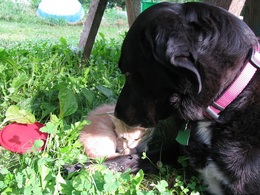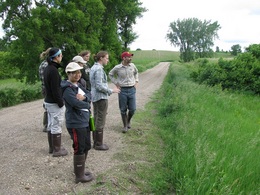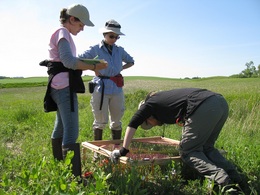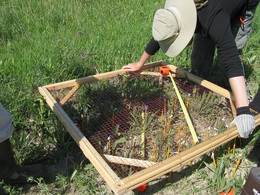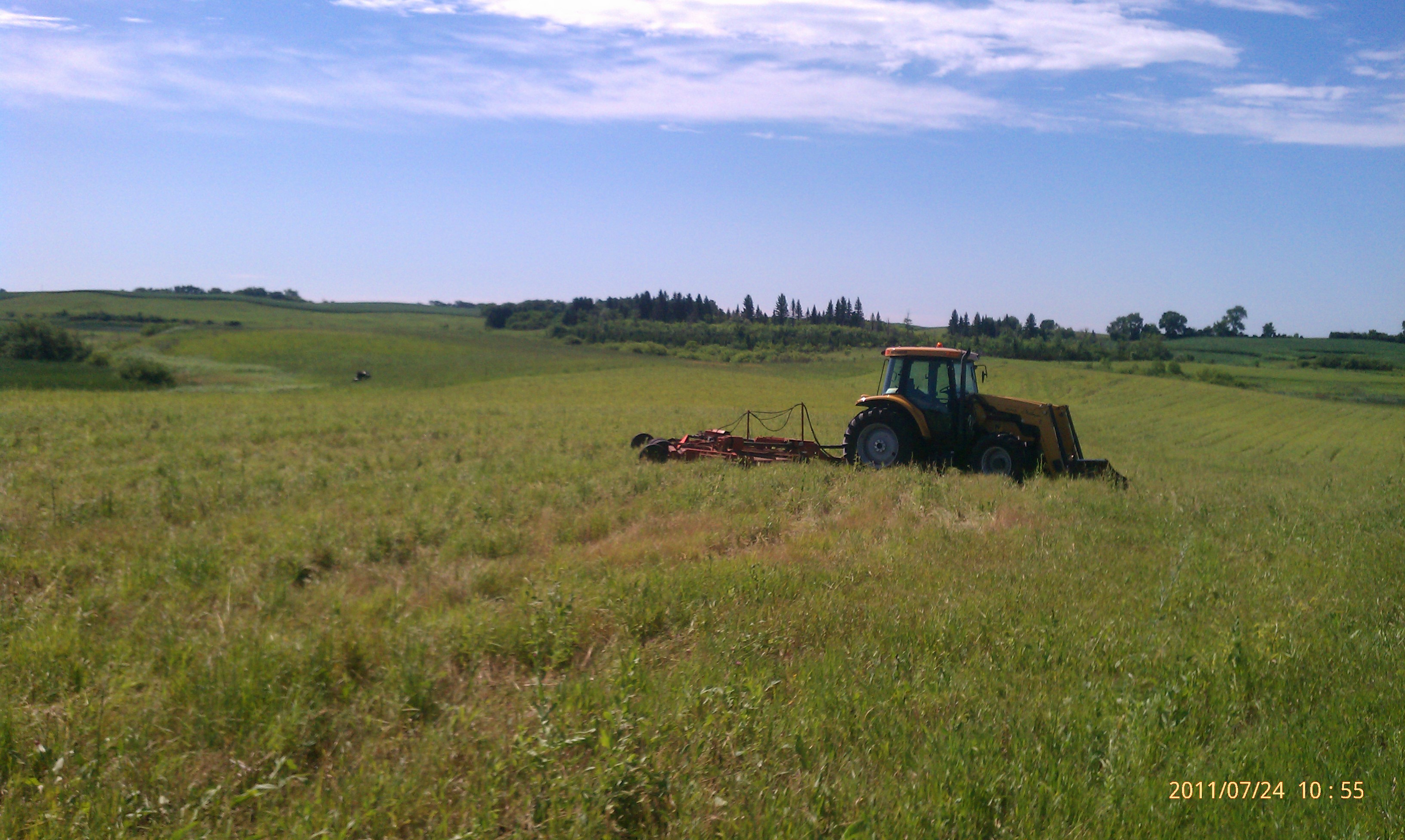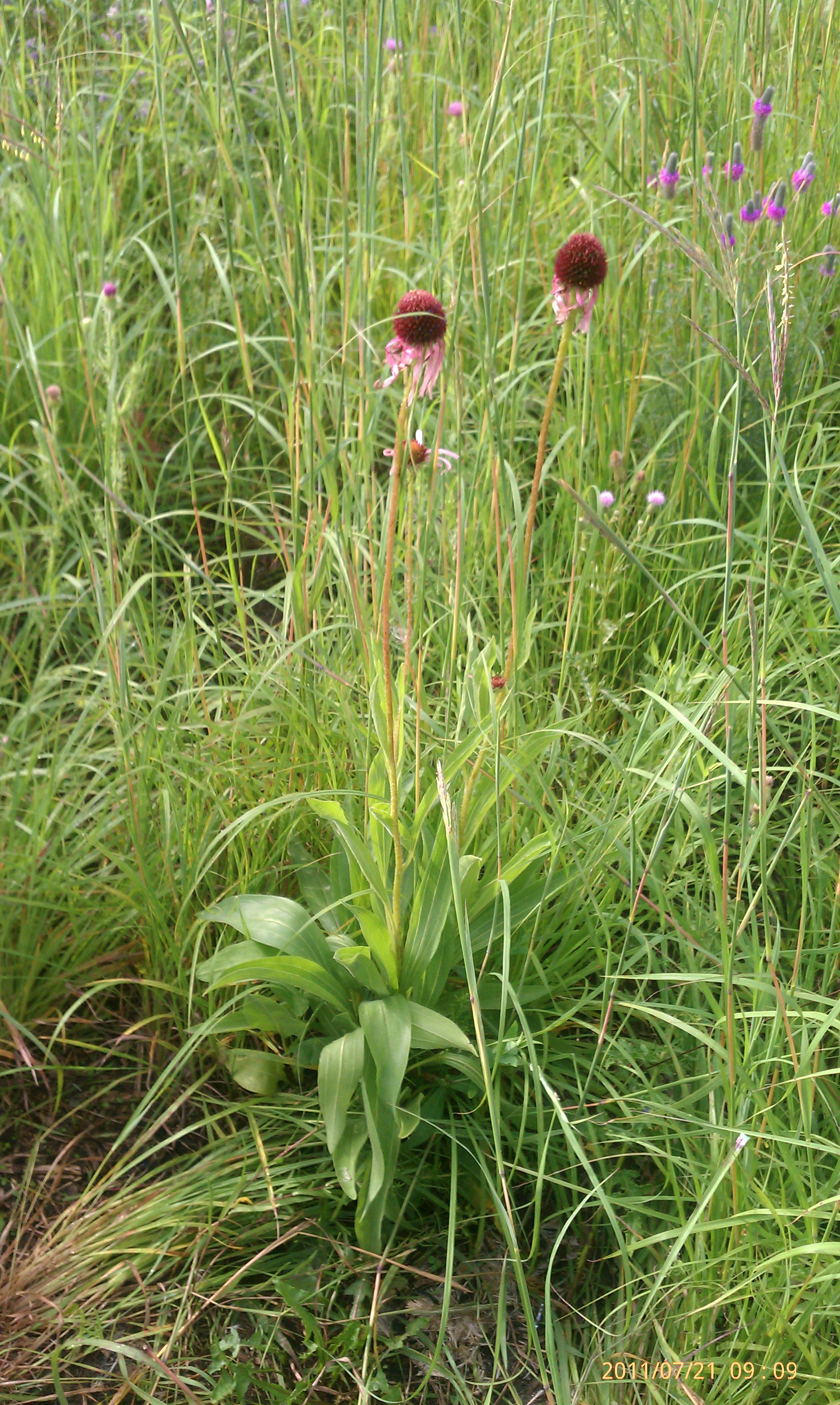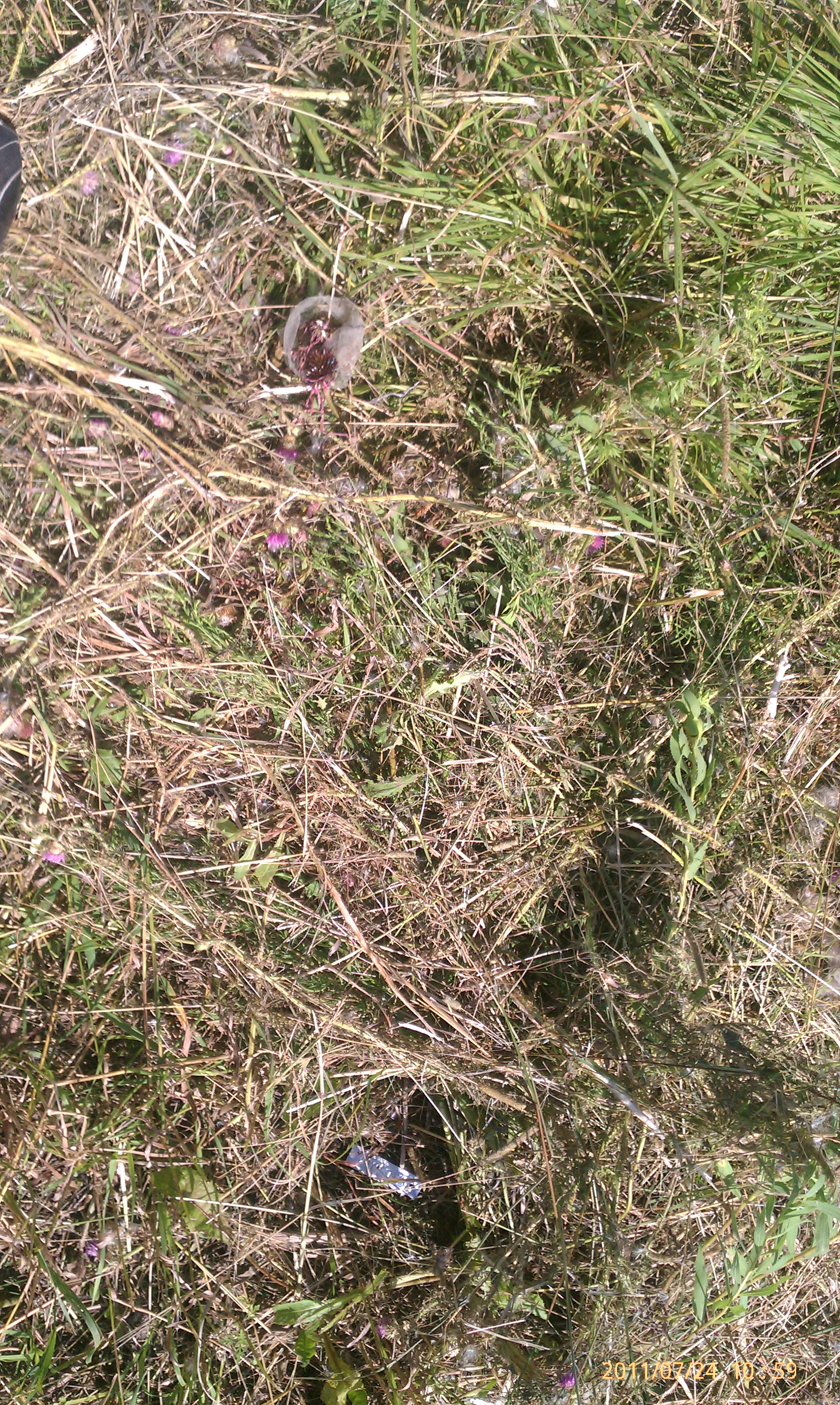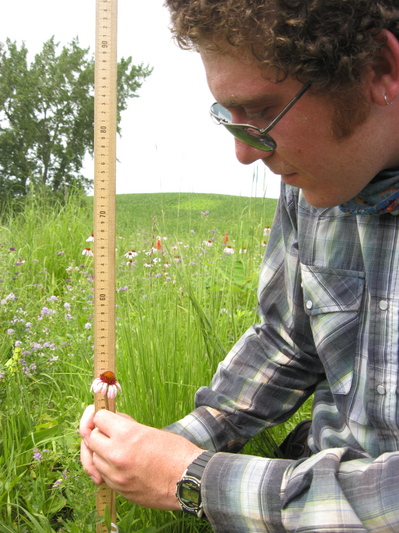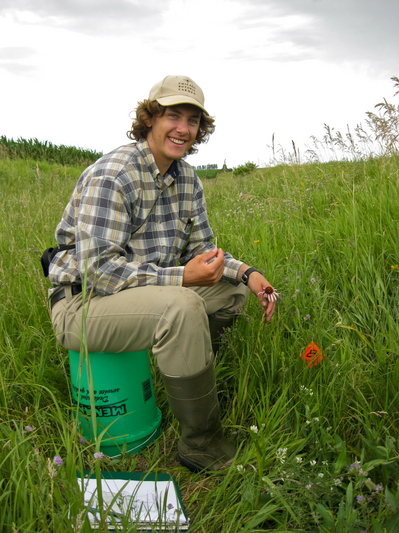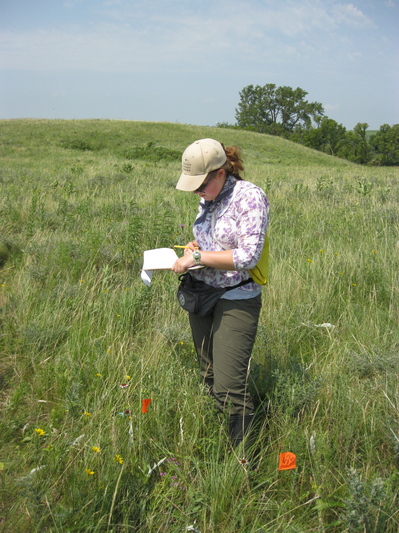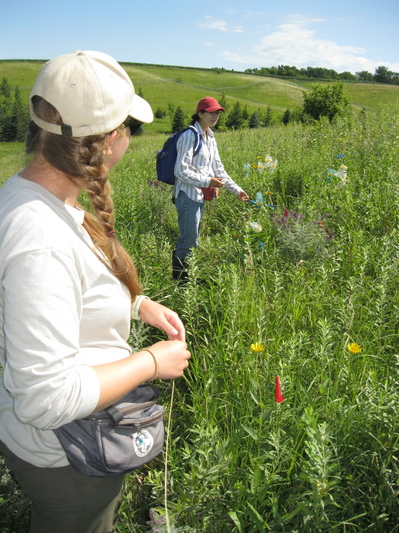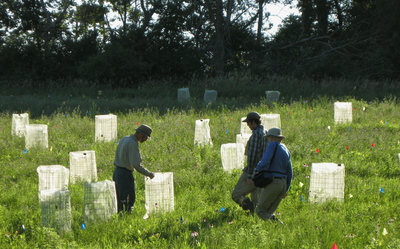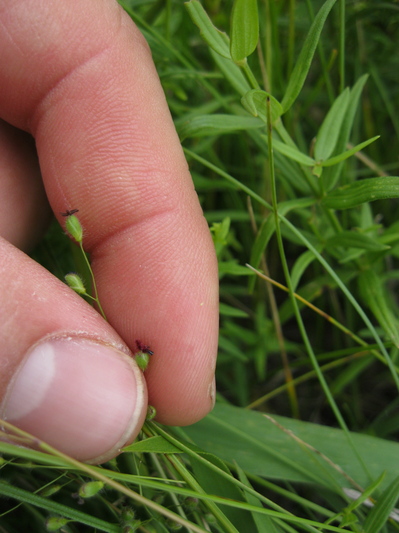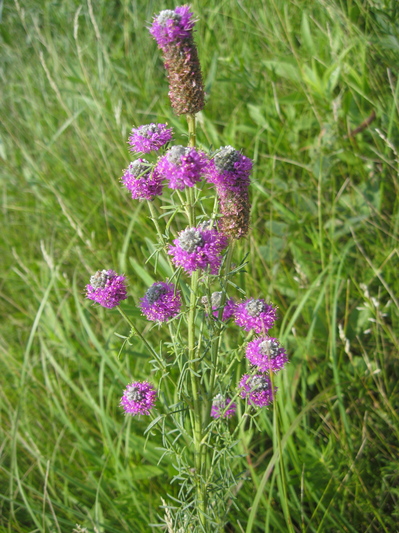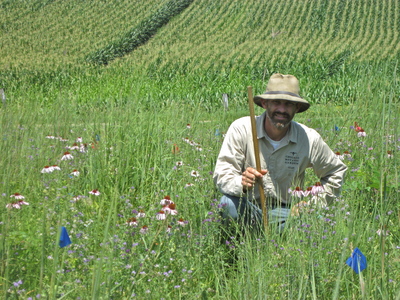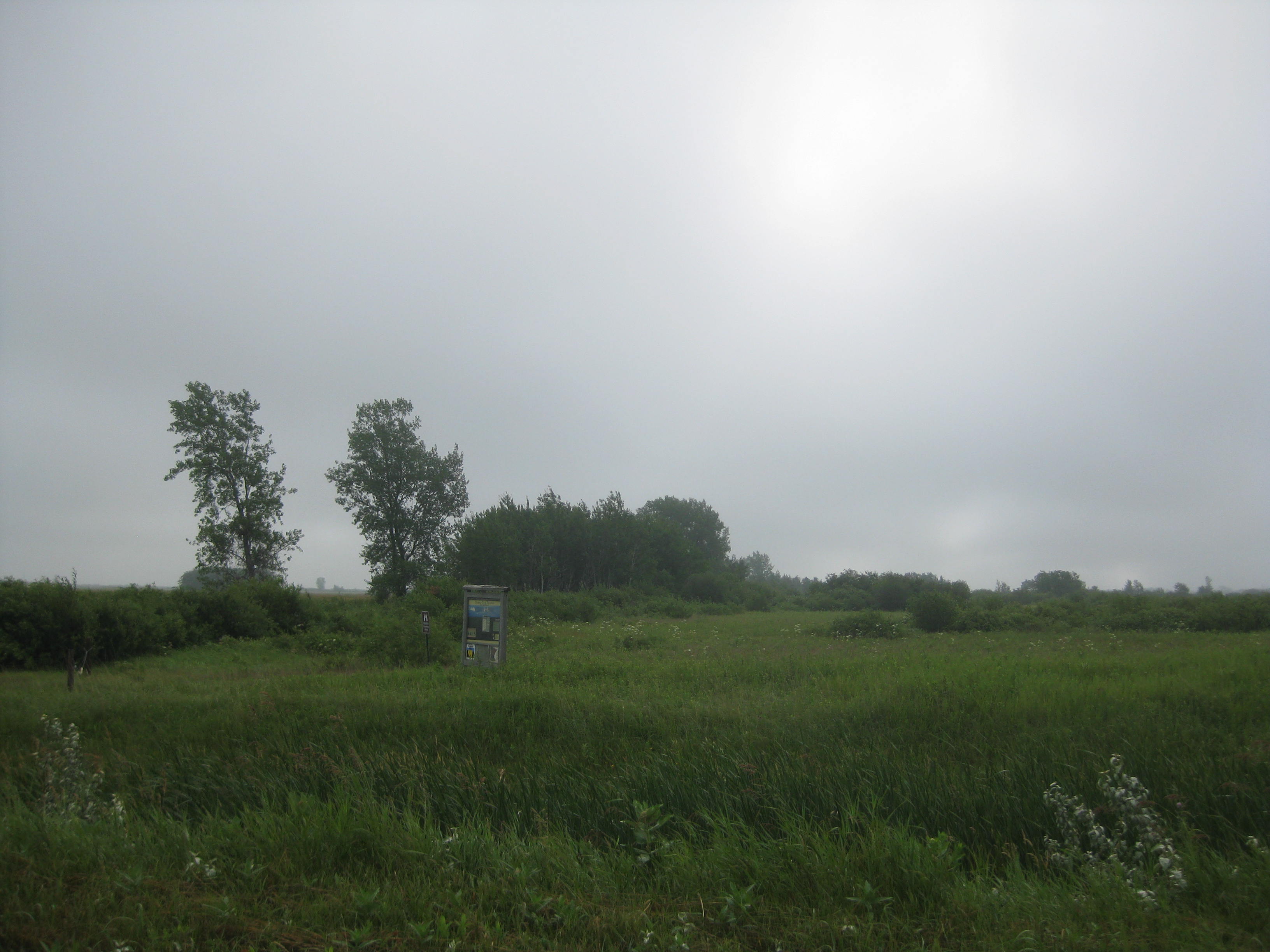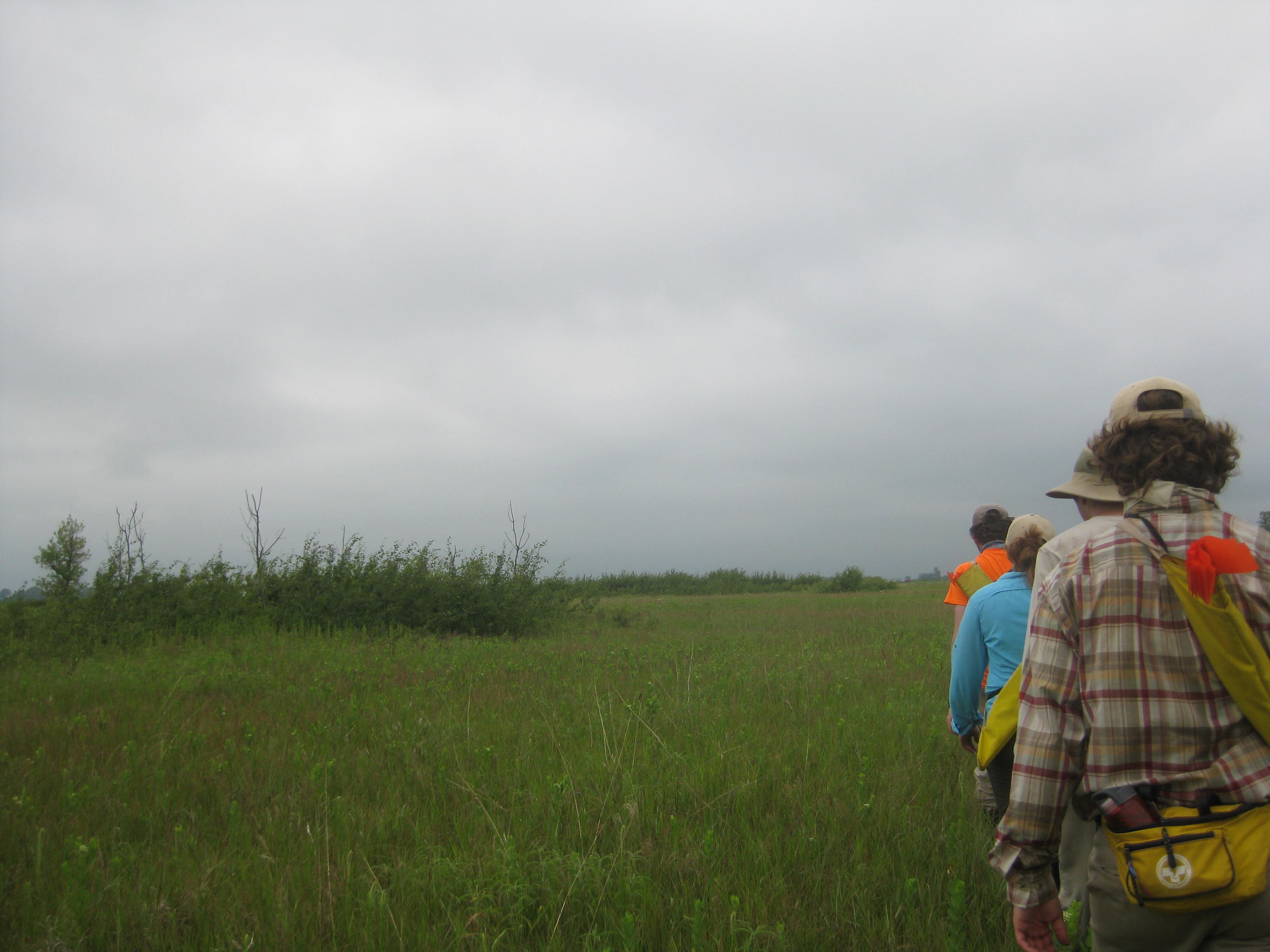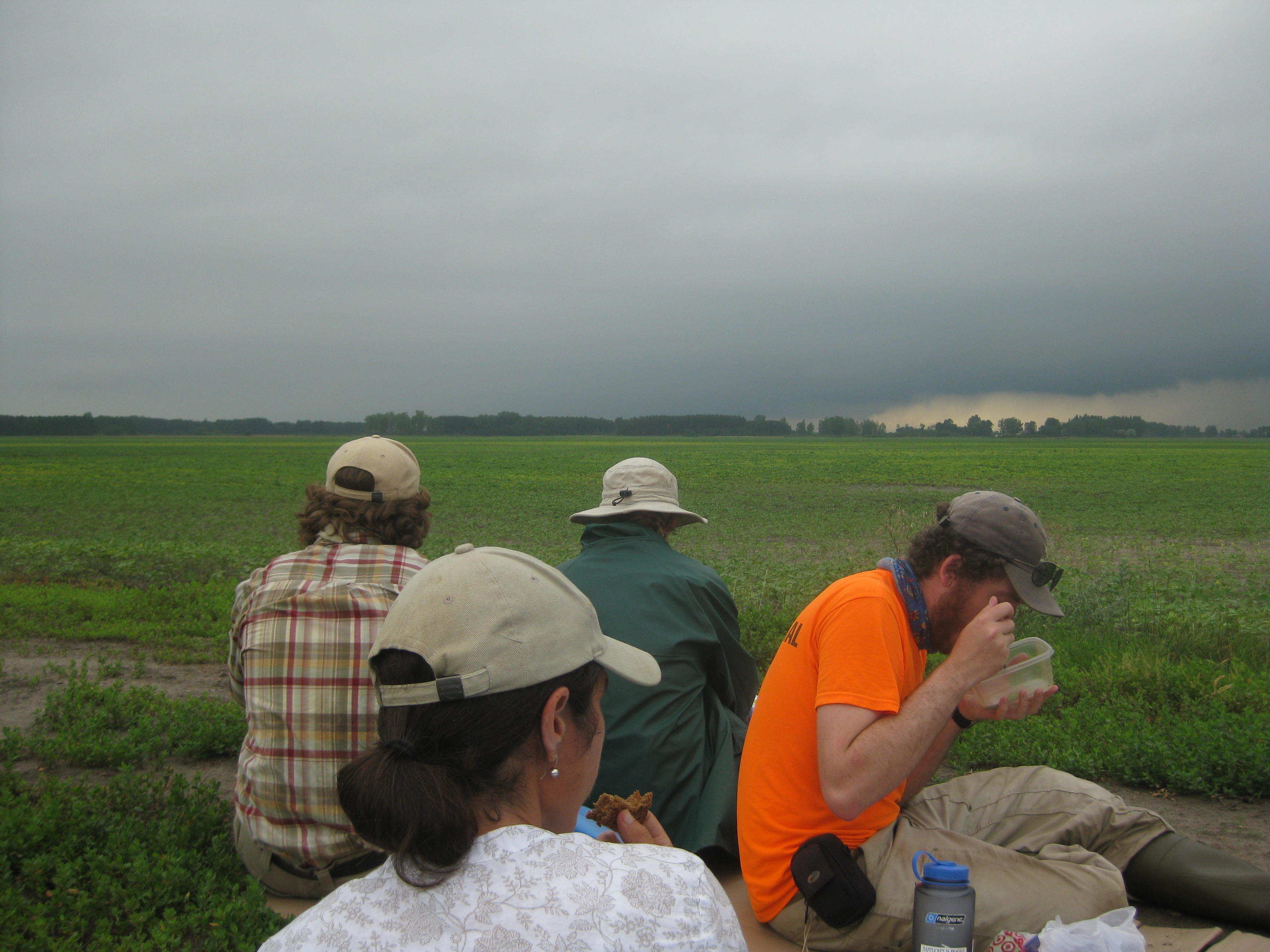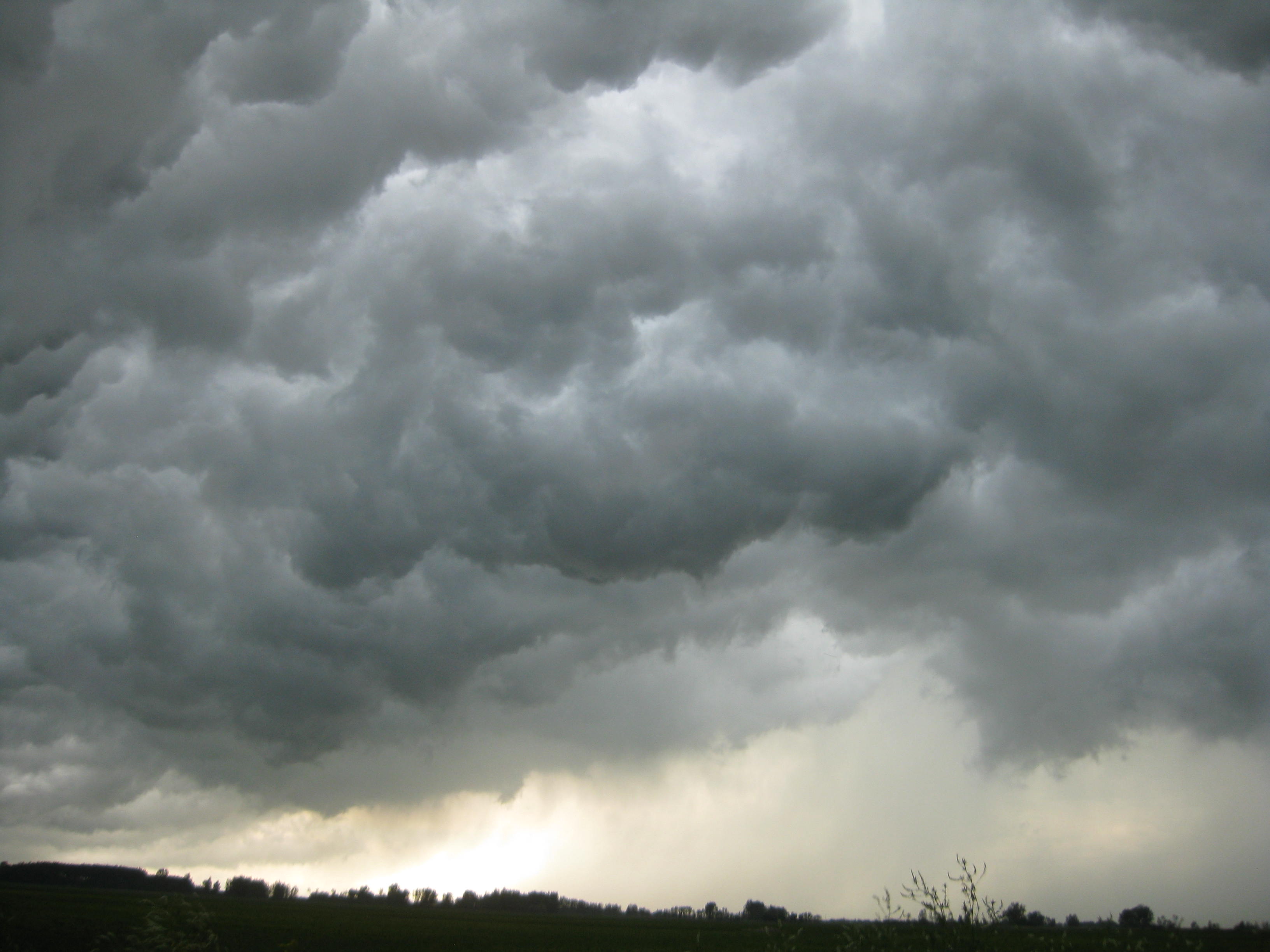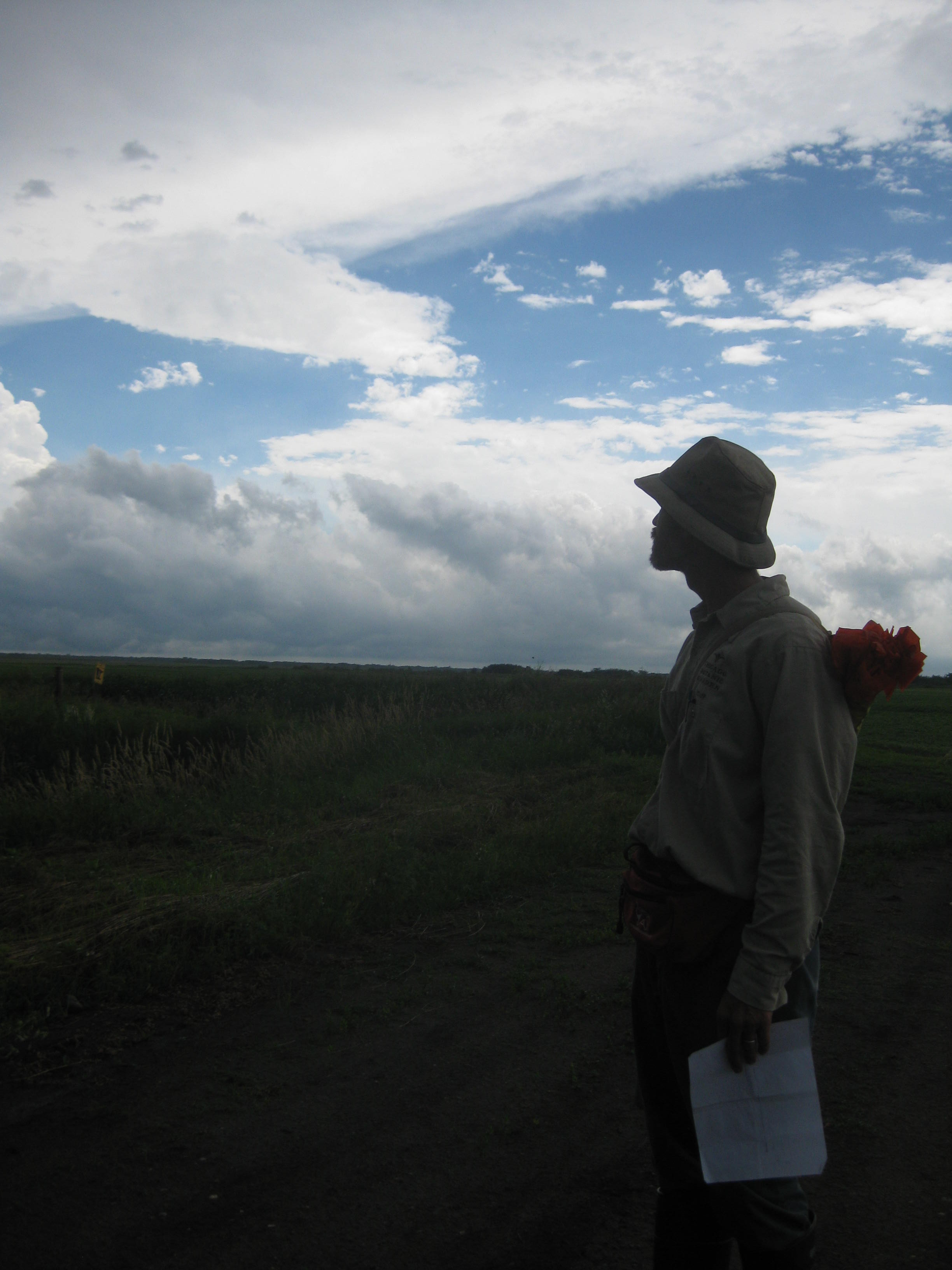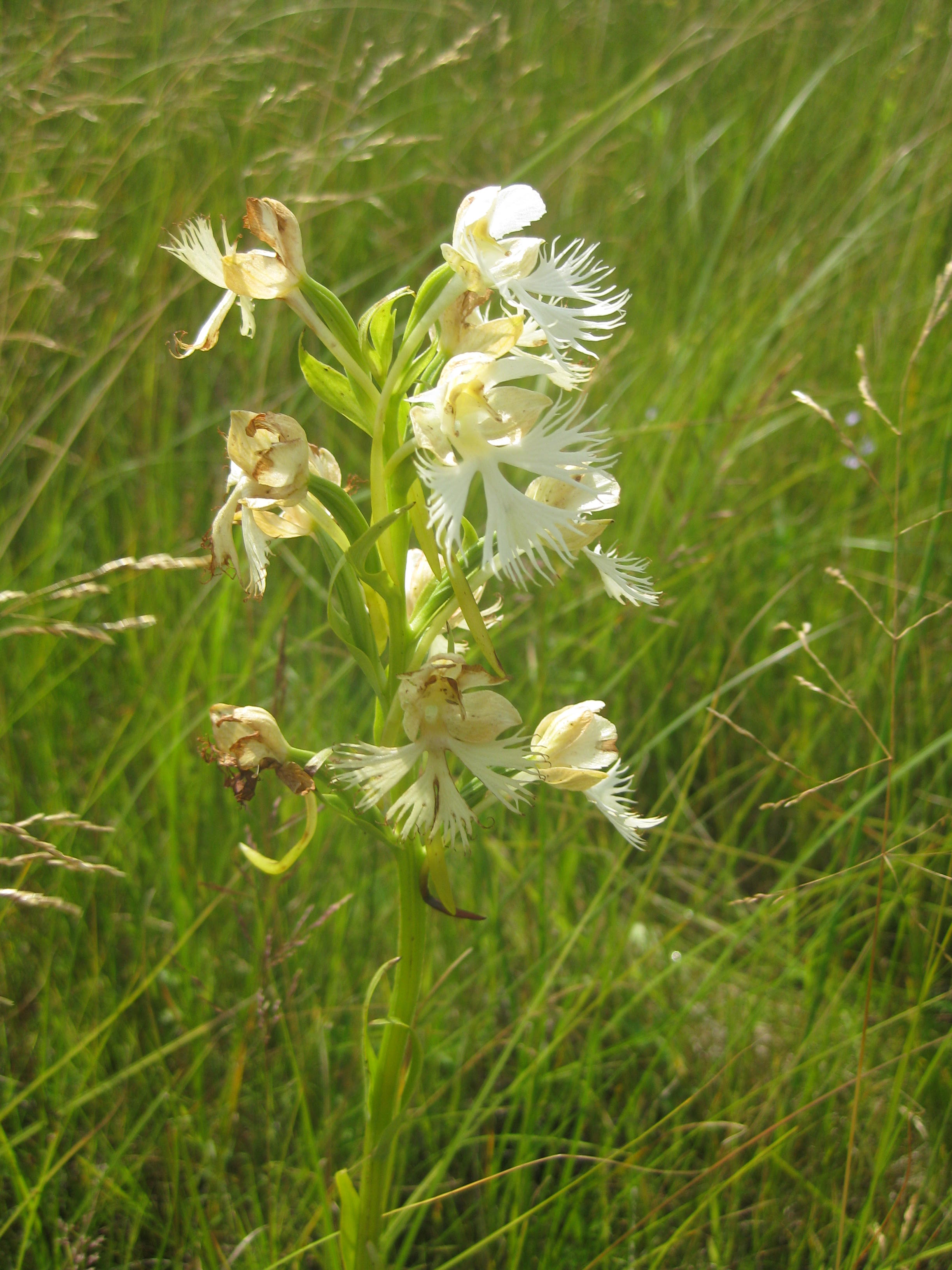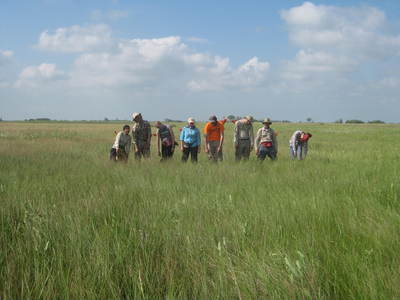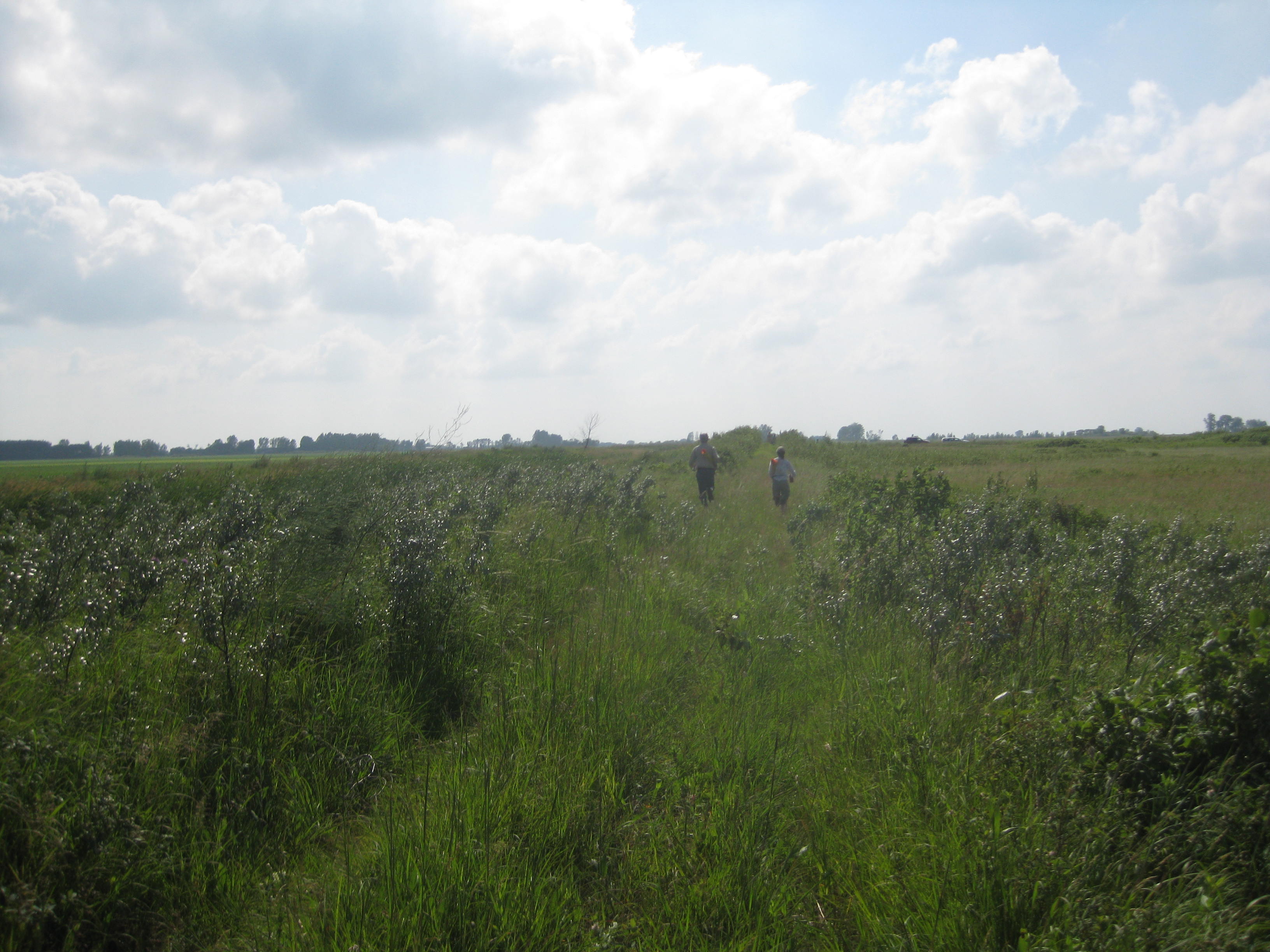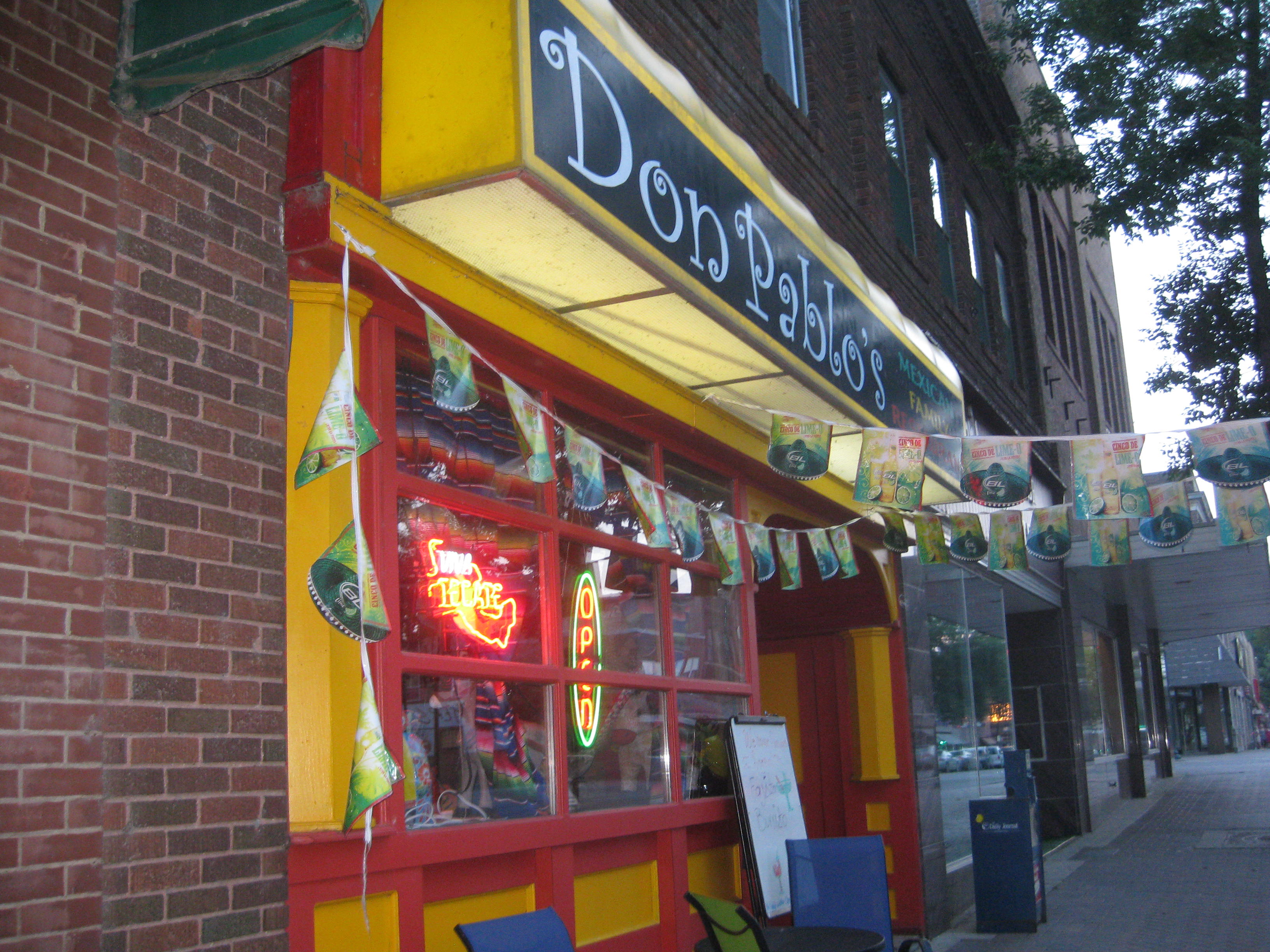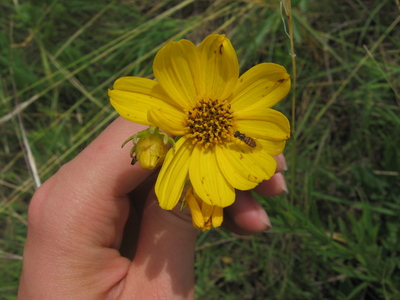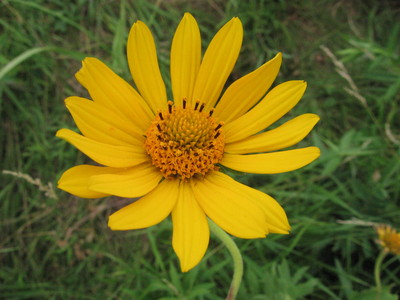|
|
Here are the day’s events:
When we arrived at work this morning we came upon a poignant scene. The Wagenius’ family dog, Roxie, had was nurturing an abandoned kitten:

I’m happy to say the poor creature has found a home with Kelly and her parents. Thanks to her loving care (and Roxie’s), it is now purring and mewling with gusto.
Once the kitty situation was resolved, we moved on to more serious business. Shona, Maria, Kelly, and Lydia spent the morning working on their individual projects while the rest of us assessed flowering phenology in two experimental plots (C1 and C2).
A lot of work goes into maintaining an experimental plot. In order to keep C1 from being overgrown by woody plants, several of us spent the afternoon trimming ash trees and sumac. The rest of us made progress on our individual projects. Thanks to help from Kelly and Lydia, Jill and I succeeded in setting up ant traps for all but one of our field sites. I’ll post more about that later.
Katherine here.
Most of the Echinacea crew arrived on Sunday. The week has gotten off to a running start. Here are some pictures from our first few days in action:



Howdy folks! This week field work was delayed by a couple of wet spells, but thanks to reinforcements (thanks Ruth!), we conquered seedling refinds at Loeffler’s Corner on Tuesday; East Riley and Riley on Thursday. Due to lack of time/manpower, we decided to scale back on seedling refinds (by focusing on searching circles that were reported to have at least 1 seedling). The frame maps made using R and the frame coordinates we recorded in June were really helpful.
Yesterday after lunch, the 4 of us (Stuart, Josh, Katherine and I) went out to Hegg Lake. I brought my bike out so I could pull in my Dichanthelium flags from my sites at Hegg Lake, and then I biked to C2 to join in the head harvest. I believe we harvested just over half the heads from C2. After that we headed back to Hjelm House and started harvesting in C1 until it was time to go.
This morning we went out to Staffanson in the truck. Stuart, Josh, and Katherine flagged plants for seedling refinds and harvested Echinacea heads as part of Amber Z’s project. I did my final round of collection at Staffanson and then pulled in flags from the plot that was planted with seedlings in June. After lunch, we paired up and continued harvesting in C1. We filled up NINE grocery bags with Echinacea heads in just one afternoon! Uff da! That was really a heck of a harvest! Good job Team Echinacea!
Heya! Here’s Maria reporting from the Town Hall.
Many of our team members had returned to school/civilization in the past 2 weeks: Nicholas, Lee, Amber Z, Amber E, Gretel, Per, Hattie, and Stuart. Thanks to Northwestern’s quarter system, Katherine, Josh and I are still here. I’ll be leaving next Saturday, Katherine the week after, and Josh two weeks later.
For the past week, we’ve been continuing to work in the field while Stuart was at the Chicago Botanic Garden. Here’s a brief recap of what we did:
Monday: Katherine did C1 Phenology & started harvesting while Josh and I finished GPSing flowering Echinacea at Krusemark (after getting stuck with the truck, the GPS went dead on us – Friday was definitely not our lucky day). We joined Katherine and did harvesting for the rest of the day.
Tuesday: Harvesting at Hegg Lake C2 garden & my last round of Dichanthelium harvesting on the way in to C2 and at Loeffler’s Corner. After lunch, we started flagging plants for Seedling Refinds at East Elk Lake Road, and then got started on a few plants.
Wednesday: Katherine worked on C1 Phenology and her aphid experiment, while Josh and I went out to GPS and harvest Dichanthelium at Loeffler’s Corner, Hegg Lake, and Staffanson. We finished GPSing all Dichanthelium sites! After lunch, we continued seedling refinds at EELR.
Thursday: While waiting for the field to dry up, Josh went out to GPS the Astragalus planted in the C1 ditch and his grasses plot. Katherine and I worked on indoors stuff and our own projects. After that we went to EELR and finished seedling refinds for all but 2 plants that would require extra information (like missing maps). After lunch, we did seedling refinds at East of Town Hall.
Friday: Aphid survey and C1 harvesting took us the whole day. Conference call with Stuart at lunch. Josh discovered grapefruit sprouting from seeds in his grapefruit at lunch. Corn-on-the-cobs and lovely eggplants made our day. Big thank you to Bob Mahoney & Dwight & Jean 🙂
The weather is cooling up so we’ll be starting work at 8.30am again. Stuart will be back on the field tomorrow. Hope we’ll have another honest week’s worth of work! 😀

5 Crew members hiked out to Krusemark’s to rescue Josh and Maria. The truck was stuck in a hole in a very soft 2-track. Order has been restored to the last field day for many of the crew. Josh, Maria, and Katherine will continue working for another few weeks and hopefully remember to stay to the LEFT!
During the last week of July, in addition to working on our independent projects, we spent lots of time measuring in the Common Garden. It’s kind-of like a yearly check-up for all the Echinacea plants there: we count their leaves and rosettes and heads, measure their stems and longest leaves, and check them for bugs or other damage.
However, this past Monday we were forced to take a break from measuring due to a huge storm! The wind knocked down lots of trees. One landed right on the Hjelm house roof! Luckily there wasn’t much damage, and everyone is safe and sound.
Tuesday was also eventful, but in a different way: It was Callin’s last day with Team Echinacea before heading back to New Mexico to teach for another year. Good luck Callin! We miss you!
Later in the week, we finished measuring in the Common Garden and started demography. Demography is when we visit all the remnants in the Echinacea Project’s study area to locate and collect data about flowering plants. It’s been fun to visit some of the sites I hadn’t been to before, and to see how the different land-use history of each has affected the plants that grow there.
Then on Friday we went to Staffanson Prairie Preserve to check on the seedlings we planted there earlier this summer. It looks like mortality was pretty high, but we only finished searching about a third of the planted area, so maybe the seedlings are doing better in the rest of the plot. I guess we’ll find out next week!
After enjoying the pig races out at the Grant County Fair yesterday, it was back to field work for me today. I biked out to the Hegg Lake Restoration area to discover that my Echinacea pallida site had experienced something that is now common for many prairie remnants – mowing.

Echinacea pallida tagged PAL 1014 before mowing:

Echinacea pallida tagged PAL 1013 after mowing:

Luckily I still have a decent number of crosses, and this just cuts the number I was planning on having a bit shorter. Tomorrow I will begin crosses to use up my remaining supply of Echinacea pallida pollen.
We accomplished a lot, even thought the weather was super hot! We even started at 7 am to try to beat the heat.
Monday, (July 18, 2011) was amazing in two different ways. The temperature was in the nineties, but the heat index was over 100 F. We worked in the morning, but by 10 am it was heating up. Because of the humidity, our clothes were soaked through by the end of the day. We measured plants in the common garden on Monday afternoon, and helped Katherine set up cages for her aphid experiments.
Here’s a picture of what we felt like on Monday: (Notice the sweat on Josh’s brow as he measures the height, in centimeters, of the Echinacea head.

Tuesday and Wednesday, we decided not to work outside during the afternoon, so we did morning field work, and then spent time updating the website and computer work during the afternoon.
Here are a few photos of our projects.
1. Callin’s Compatibility Project:

2. Amber Z’s Phenology Project at Staffanson Prairie Preserve

3. Lee’s compatibility project with Coreopsis palmata and Heliopsis helianthoides

4. Katherine’s Experiment with aphids. She set up lots of cages to keep aphids in the right places. Very cool!

5. Josh is helping other groups and helping with the main projects, because he’s waiting for his Big Bluestem and Indian Grass to grow for his experiment (sorry, no photo).
6. Maria has been collecting Dichanthelium seeds for later experiments. Check out the cool purple flower of Dichanthelium in the picture.

7. Amber E. has been collecting pollen from Dalea in lots of different remnants (sorry, no picture). Dalea purpurea is a purple flowering legume.

8. Nicholas is just about to finish all his compatibility experiments between Echinacea angustifolia and Echinacea pallida. To do cross pollination experiments, he first paints the bracts that subtend the styles he will pollinate. Aqua is a easy color to recognize on the bracts.

On Thursday and Friday, we were able to do more fieldwork in the common garden, even in the afternoon (common garden measurements and phenology).
We also had time to practice taking some photos for the website. The photo below shows Stuart scouting a good location for a website photo.

Yesterday we went on a trip to the Crookston area to help Gretel with her White Fringed Orchid search. Here are pictures for your viewing pleasure 🙂
The day started off hot, but not excessively hot…..

Gretel and Stuart leading the pack.

Trekking into the prairie.

We worked in groups of three, with Gretel, Stuart, and Josh visoring in each group and the rest of us flagging and counting.
After working from 9+am to around 12.30pm, it was lunch time!

We proceeded to have lunch picnic style, but not for long – because a storm was headed our way!


We quickly headed back to the cars for safety, and watched the awesome storm while eating lunch. Fortunately the storm passed over quickly, and soon the skies were clear again.
Stuart contemplating the skies.

We went back to work in another section of the prairie for the rest of the afternoon.
Lee searching for orchids. ‘Where forth art thou, white orchid?’

And there you are! (usually right under my nose)

Around 4+, we finally finished searching the plots…we were quite exhausted by then…

but we were done…Victorious Team Echinacea!

The amazing couple who still had the energy to race back to the cars.

After that we drove back to Douglas County. Stopped at Fertile, MN for ice cream but sadly they were closed on Saturdays. Also found out that Cafe 116, the dinner place in Fergus Falls we were going to, closes at 6pm on Saturdays. So we had a pretty sumptuous dinner at Don Pablos, a quirky Mexican restaurant in Fergus Falls 🙂

Reached Hjelm House around 9 or 10pm. That was a long but fun day! 😀
This past week a lot more Echinacea started flowering, which meant we had plenty to do. We located all the Echinacea plants in the Common Garden that will flower this year. There were so many! They seemed to be particularly abundant in the 99 garden.
We also completed some more aphid surveys for Katherine’s project, continued work on the New Media Initiative, and set insect traps for Greg’s project. I really enjoyed taking a quick peek at some of the insects that Greg’s traps caught. I don’t have tons of experience with insects, so I don’t know what genus any of them are yet, but some of them looked pretty nifty. I’m looking forward to finding out more about them.
My own independent project is coming along as well. I’ve been spending quite a bit of time this week working at the dump! For those of you who aren’t familiar with the prairie remnants we’re studying, I should clarify that I’m not actually working in a garbage heap. There are some little hills that haven’t been used for agriculture because they are within the landfill’s property, but they’re not really close to all the trash either. As a result, they are covered in beautiful native prairie species! (And when the wind’s coming from the right direction, it doesn’t even smell bad!) Two of the species I’m studying grow there, Coreopsis palmata

and Heliopsis helianthoides.

I’ve started doing pollen crosses, with mixed results. On the Heliopsis, it looks like styles shrivel after receiving outcross pollen (suggesting they have been successfully fertilized), but not after receiving self pollen. I had a harder time seeing what happened to the styles on the Coreopsis I crossed because when I went back to check on them two days later, some of the flower heads had started falling apart. (As Amber Rae put it, “The Coreopsis are losing their heads!”) Stuart says that this is unusual though, so hopefully the heads I use for crosses this coming week won’t fall apart and I’ll be able to get some clearer results.
|
|

